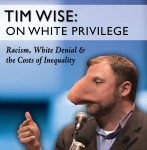 Continuing a review of fundamental ideological distinctions between jews and Whites.
Continuing a review of fundamental ideological distinctions between jews and Whites.
In August 2000 Tim Wise provided his own personal jewish narrative – clearly identifying himself as a jew, his sympathies for jews like his grandfather, and describing how it fuels his antipathy for Whites:
For the sake of becoming American (and that had really meant to become white), one had to give up what one was, in order to metamorphose in Kafkaesque fashion into something one was not: a white man.
At the end of the day, even with the advantages that come with transformation, one has to wonder if it was a decent bargain: to trade your traditions and political-cultural soul for a permanent guest pass at someone else’s club, and a shot at the vice-presidency. The self-doubt we Jews have on this score is likely part of the reason we cling to the model minority myth with such dialysis-machine like ardor: it allows us to think it was worth it after all.
The terms minority and majority reveal a significant distinction between jews and Whites. Ordinarily a minority group is regarded as morally superior to the majority, which is often justified by pointing to differences in wealth or power. The exceptions are telling: Israel, where jews are the majority, and South Africa where Whites are a minority. White minority rule over South Africa was regarded as immoral and illegitimate, was boycotted and ultimately brought down. Meanwhile, jew minority rule over the United States is denied and otherwise disguised, and exposing or opposing it is painted as irrational and immoral.
“The Jewish Question” – Jared Taylor Vs. Brit sheds further light on Jared Taylor’s view of jews. Taylor implies that there is no racial distinction between Whites and jews – that the jewish question is not a question of race. Furthermore, he claims there are jews “entirely on our side”. Taylor’s point of view is more favorable to jews than Whites. Judaism, Culture and the Gentile World: A Conversation with Rabbi Mayer Schiller provides a window into the mind of an AmRen jew.
I’ve previously discussed the idea, propagandized primarily by jews in the jewsmedia, that something being “too White” is a problem. They have exactly the opposite attitude about “too jewish”. This was illustrated by the hysterical reaction to a relatively mild and innoculous statement Miley Cyrus made last month.
Miley Cyrus: Music Industry Too Old, Too Jewish To Understand Her Appeal, at Weasel Zippers:
“It’s always weird when things are targeted for young people, yet they’re driven by people that are like 40 years too old. It can’t be like this 70-year-old Jewish man that doesn’t leave his desk all day, telling me what the clubs want to hear.”
Miley Cyrus’ Anti-Semitic Slip is Showing, at Tablet Magazine:
But Miley’s comment deserves attention because of its very particular context. As Jody Rosen poignantly noted in New York shortly after her now-notorious twerking turn at MTV’s Video Music Awards, the singer’s current reincarnation is a bit of minstrelsy
As Rosen convincingly argues, such masquerading has frequently served as “a shortcut to self-actualization” for white people, from Al Jolson onwards. Entertainers have understood and applied minstrelsy as a performative process by which white—and, in the case of Jolson, Jewish—performers could remake themselves as all-American pop stars.
Rosen: The 2013 VMAs Were Dominated by Miley’s Minstrel Show, by Jody Rosen, 26 Aug 2013:
A doctoral dissertation could (and will) be written on the racial, class, and gender dynamics of Cyrus’s shtick. I’ll make just one historical note. For white performers, minstrelsy has always been a means to an end: a shortcut to self-actualization. The archetypal example is in The Jazz Singer (1927), in which Al Jolson’s immigrant striver puts on the blackface mask to cast off his immigrant Jewish patrimony and remake himself as an all-American pop star.
Miley Cyrus’ Shocking Anti-Semitic Remarks, at Hollyscoop:
Miley Cyrus’ entire point of living is to shock people. However, baring her midriff, rapping, and loving ecstasy is no longer shocking to anyone so Miley has moved on to thoughtless racial comments.
The point is that shocking Whites is regarded as normal, while the simple mention of jews is regarded as shocking. Both the standard and the threshold could hardly differ more.
One of the more hysterical expressions of jewish outrage came from hyper-jewess Debbie Schlussel – “View” Hags Attack Jews, Defend Miley Virus’ Anti-Semitism; Jenny McCarthy: “Jews Know How to Make Money; Whoopi: “Jews Controlled Music Industry”.
Burlington Takeaway: Words Whites Can’t Say touched on a legal distinction between Whites and jews.
New Legal Tools Fight Anti-Semitism, CLJ’s Susan Tuchman Says, July 2007:
That legal tool is Title VI of the Civil Rights Act of 1964. Thanks in part to the efforts of Tuchman, anti-Semitism can now be challenged under Title VI.
The good news, Tuchman said, is that the inclusion of Jews as a protected class under Title VI was recently endorsed by the U.S. Commission on Civil Rights, a bi-partisan agency that investigates and studies discrimination, reporting its findings to Congress and the president. In 2006, the Commission recognized that anti-Semitism encompasses more than name calling and threats, and that sometimes it is expressed as “anti-Israelism” or anti-Zionism.
The Commission accordingly recommended that colleges and universities come out and condemn anti-Semitism, Tuchman explained. The Commission rejected the argument that universities could remain silent because of the perpetrators’ right to free speech; instead, the Commission said, the schools had a moral obligation to take a stand against anti-Semitic speech.
The Equal Employment Opportunity Commission (EEOC) is an outgrowth of Title VII (no discrimination in employment) of the Civil Rights Act. EEO Terminology:
Discrimination: Any act or failure to act, impermissibly based in whole or in part on a person’s race, color, religion, sex, national origin, age, physical or mental handicap, and/or reprisal, that adversely affects privileges, benefits, working conditions, results in disparate treatment, or had a disparate impact on employees or applicants.
Disparate Impact: Under EEO law, less favorable effect for one group than for another. Disparate impact results when rules applied to all employees have a different and more inhibiting effect on women and minority groups than on the majority. For example, nonessential educational requirements for certain jobs can have a disparate impact on minority groups looking for work, as they often been limited in their access to educational opportunities.
Disparate Treatment: Inconsistent application of rules and policies to one group of people over another. Discrimination may result when rules and policies are applied differently to members of protected classes. Disciplining Hispanic and Afro-American employees for tardiness, while ignoring tardiness among other employees, is an example of disparate treatment. Such inconsistent application of rules often leads to complaints.
The podcast will be broadcast and available for download on Tuesday at 9PM ET.
Podcast: Play in new window | Download










